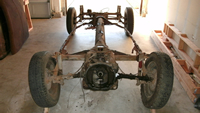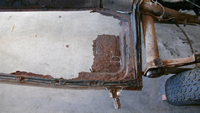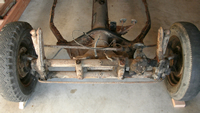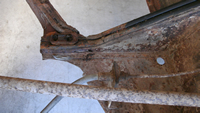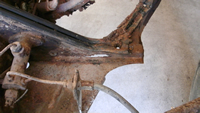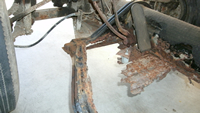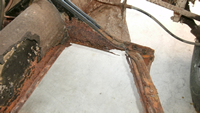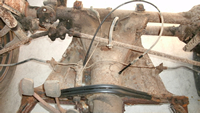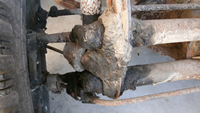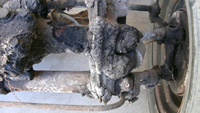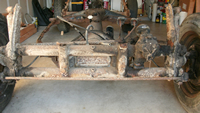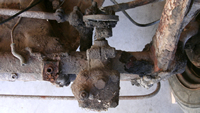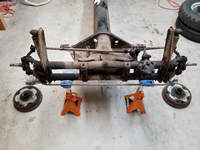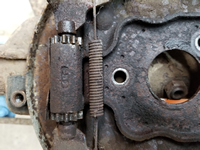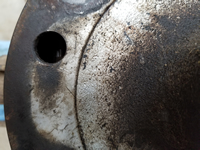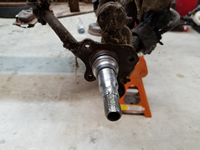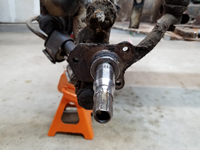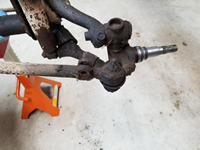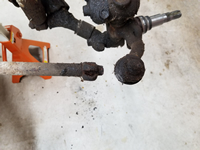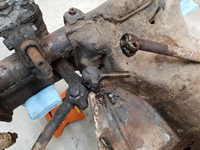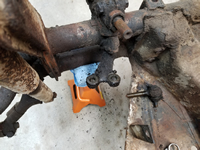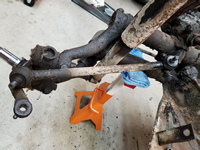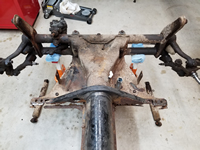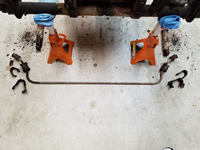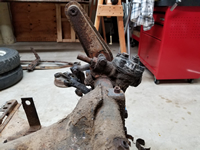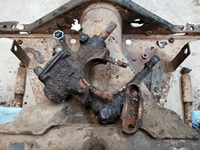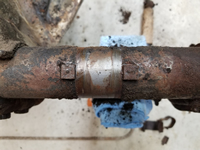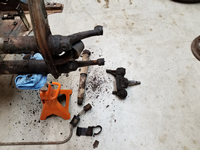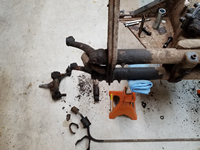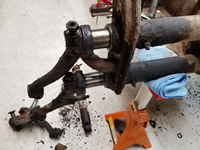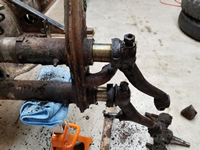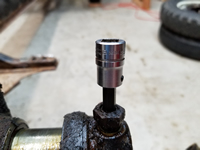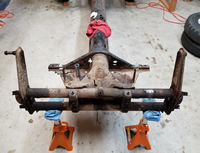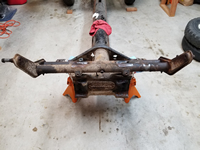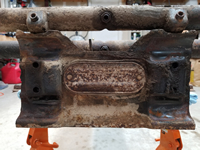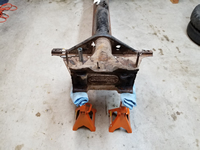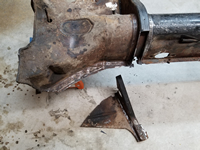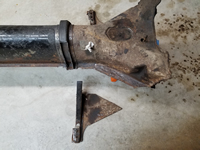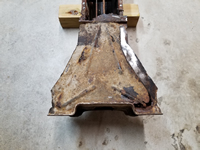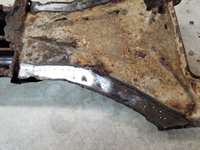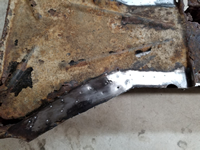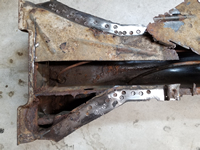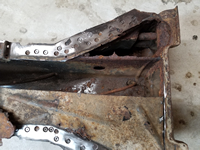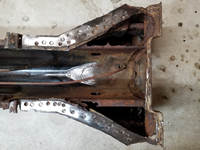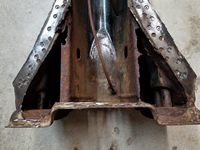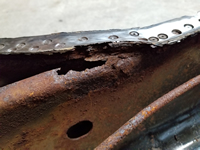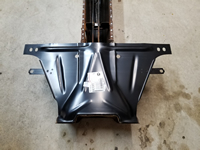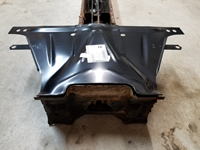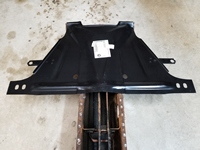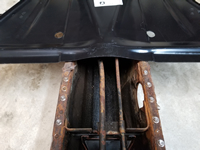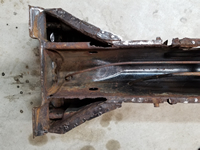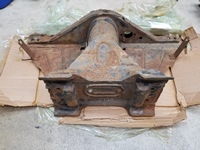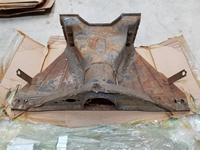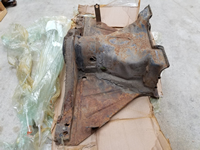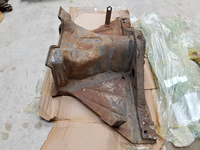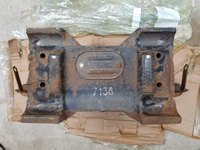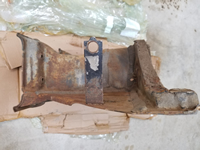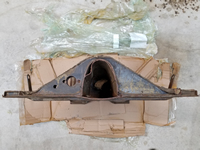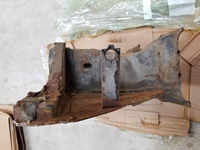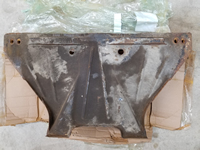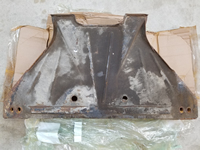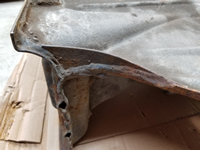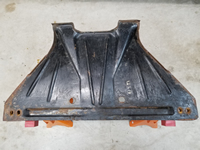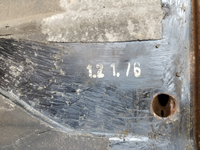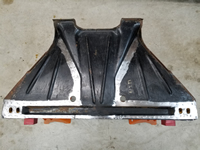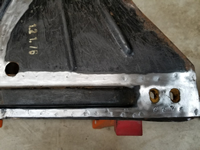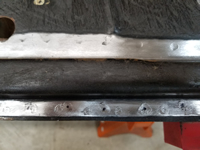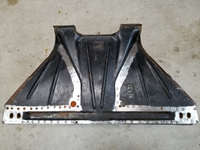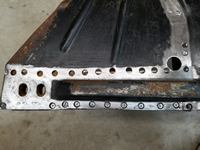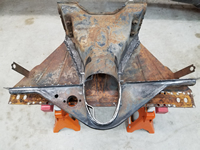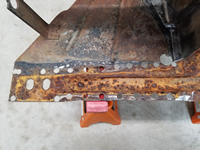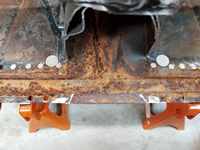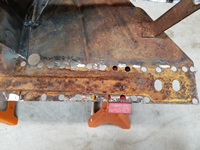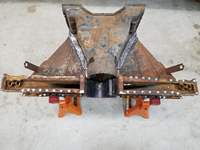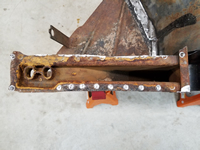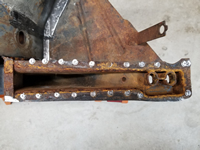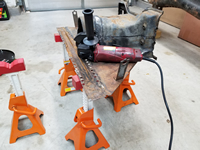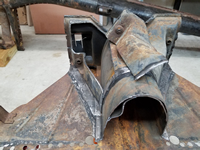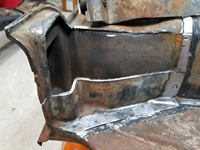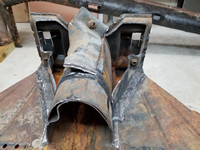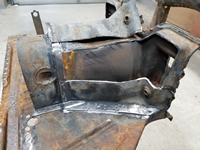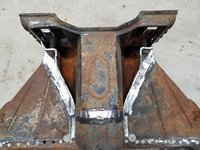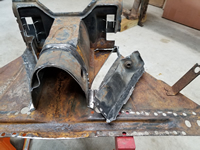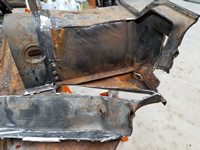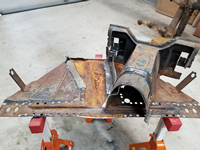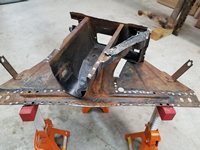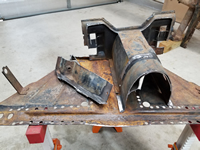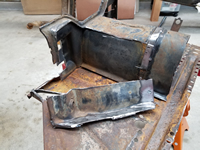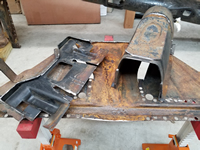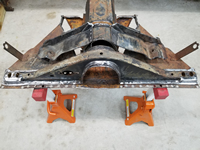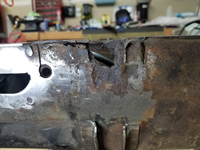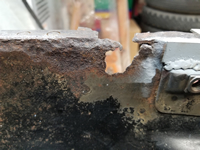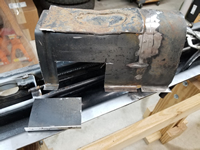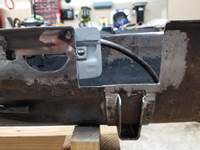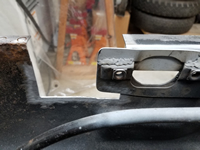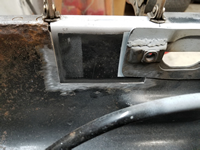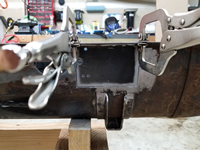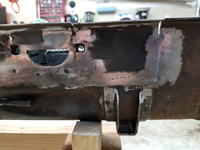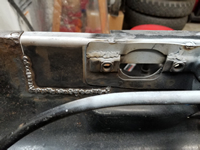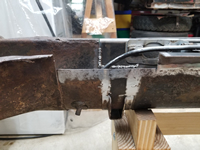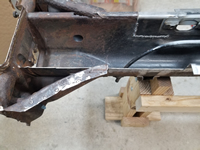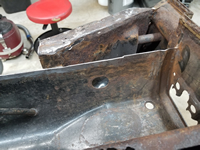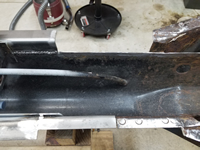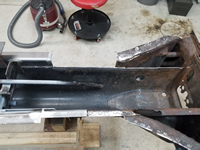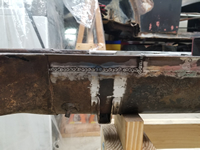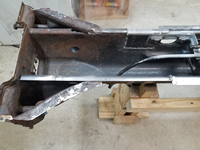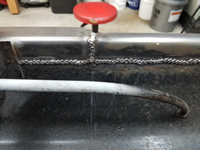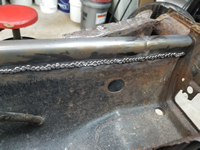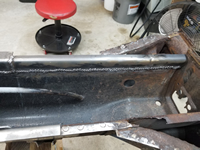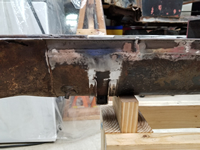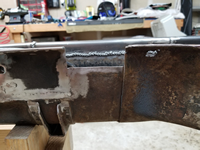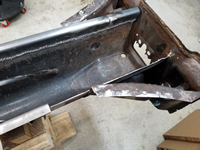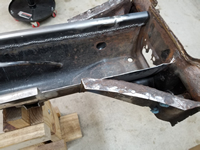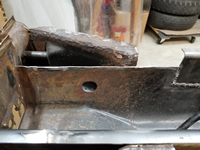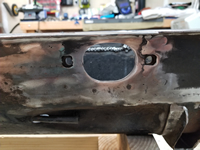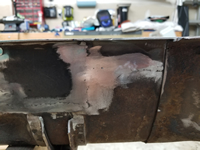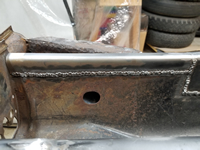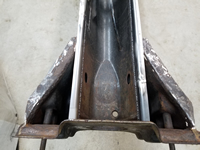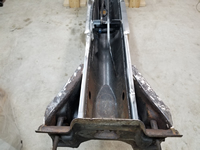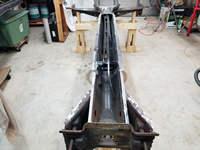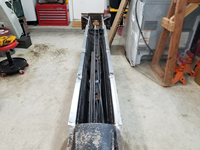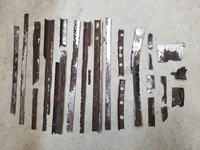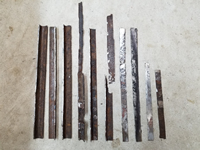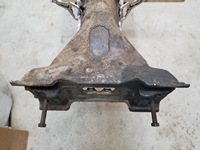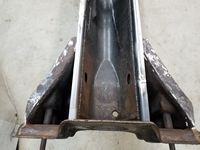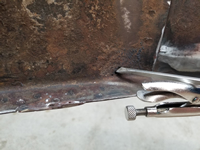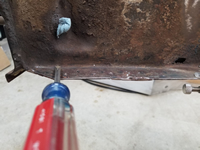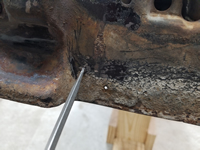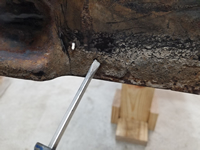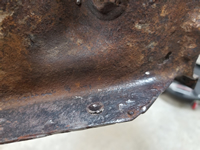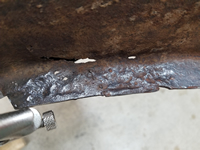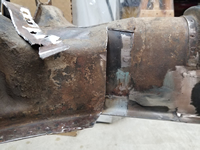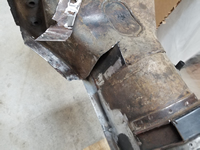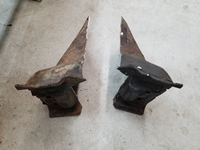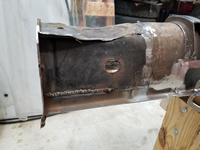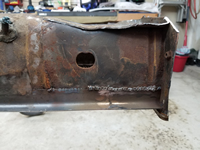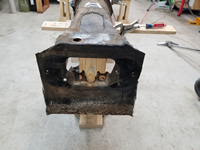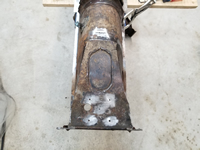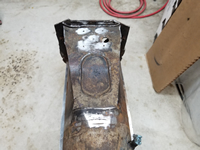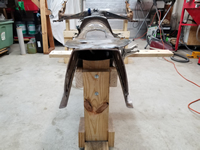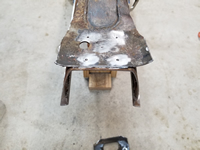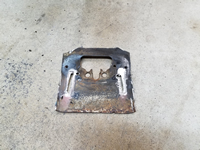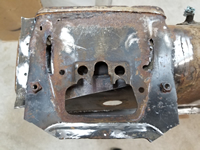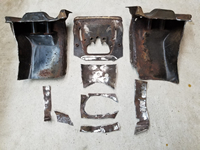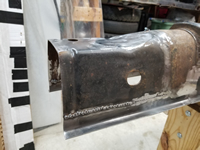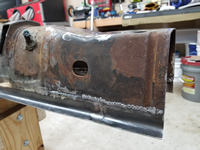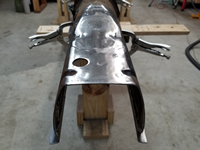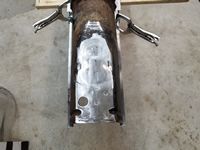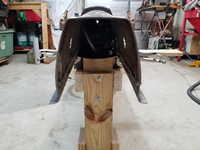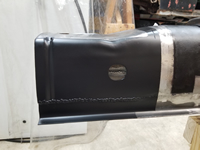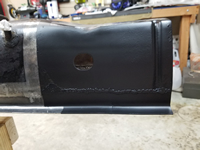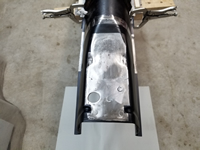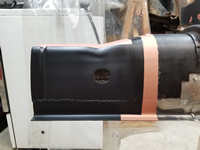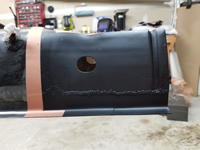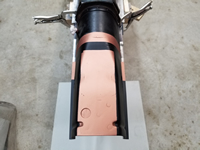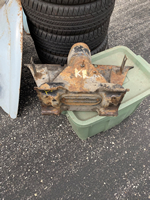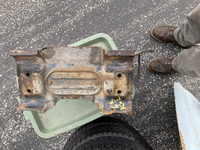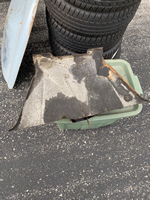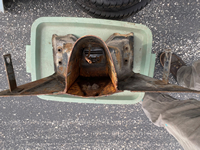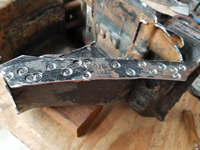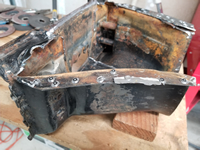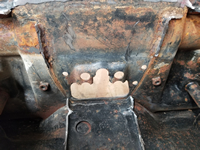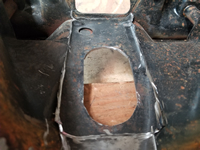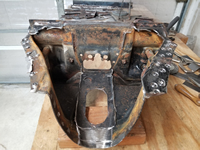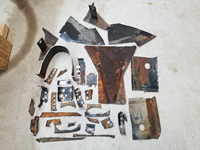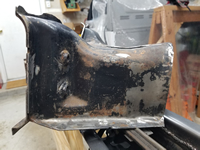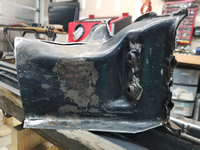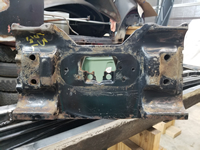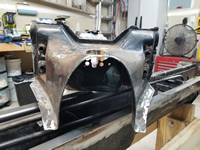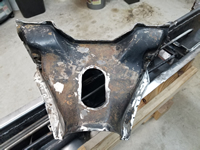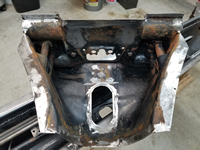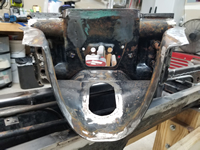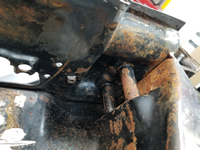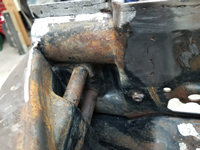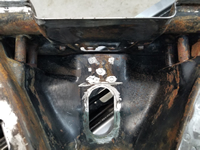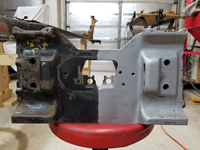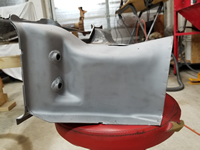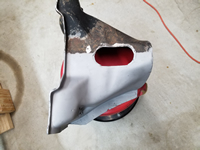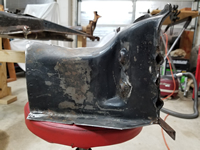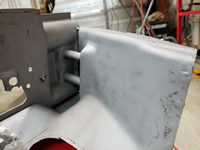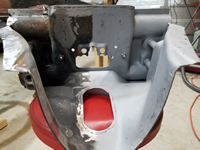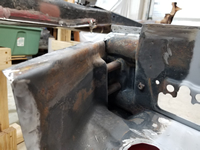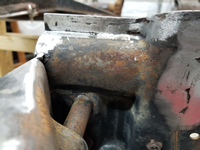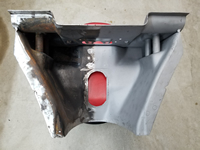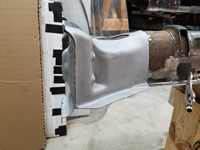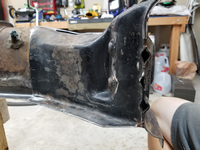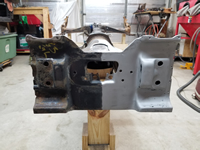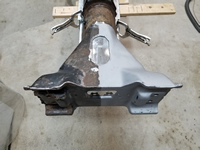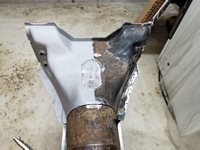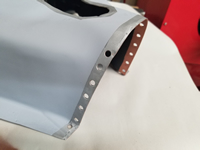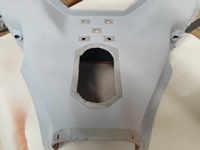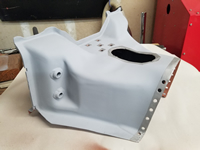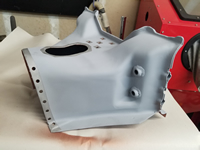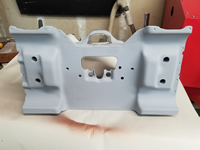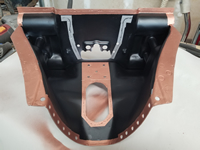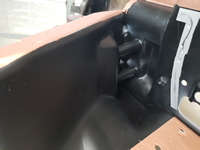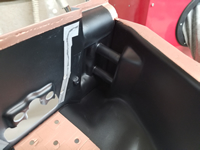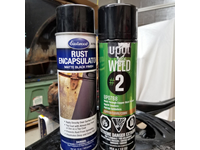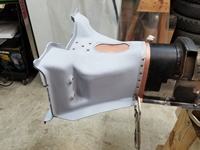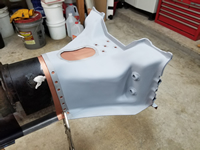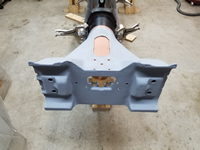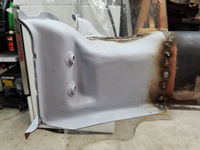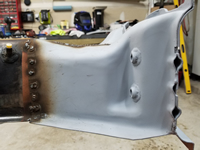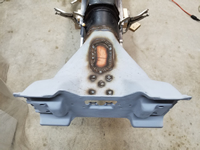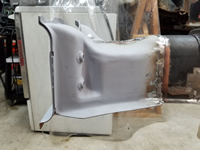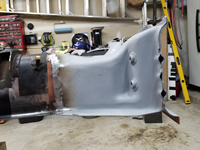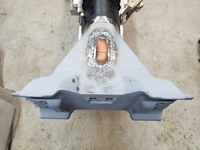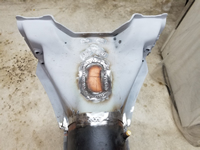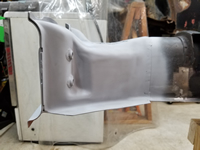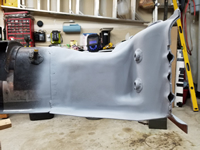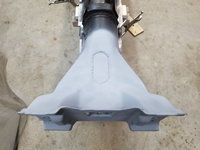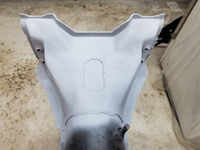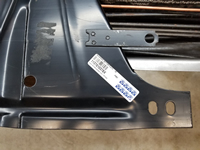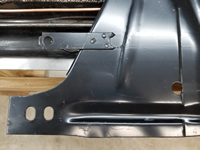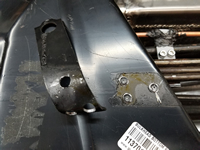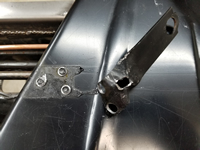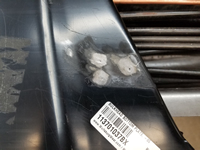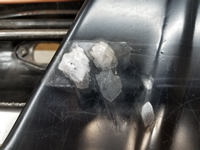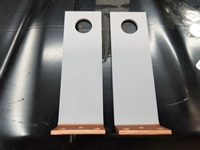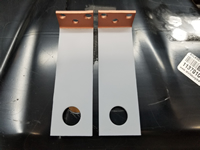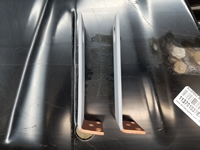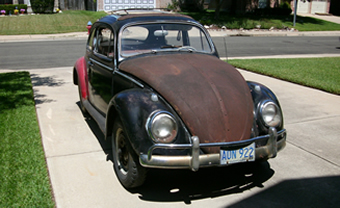Tag: frame head
Initial Assessment of the Chassis
by Garage Weasel on Mar.04, 2011, under Chassis
With the body off of the chassis, I can now get a good look at its condition. Here is my initial assessment of what needs to be repaired or replaced:
Floor pans: I guess the most obvious things that need to be replaced are the floor pans. There is almost nothing left of them except the outside frames. My current intention is to replace them with them new panels made by Wolfsburg West. These are thick and heavy-duty and seem to be the best ones available.
The Napoleon hat: The Napoleon hat or front chassis support panel on my chassis has suffered a lot of rust damage and must be replaced. These are difficult to remove due to the amount of welding where it is attached to the frame head and tunnel and have to be cut and ground off. New replacement panels are available and inexpensive, but often do not fit well and have to be greatly altered. I may buy a new one and see if it fits well enough to use. Donor parts are difficult to find, so my only option may be to use a new panel.
The frame head: The frame head has quite a bit of surface rust, but seems to be structurally sound. The bottom plate, however, does need at least portions of the plate replaced. The rear corners are rusted through where it attaches to the outside ends of the Napoleon hat and these areas will need to be replaced. Replacement bottom panels are available and reasonably priced, but it is a lot of work to remove the original one and a lot of welding to install the replacement. Right now, I’m not sure the extra work is necessary. I may just purchase a replacement panel and then make the decision. I can at least use it to cut out portions to patch the areas that are rusted away.
Front axle: The front axle is covered with road grime, oil, and dirt. In some areas it is more than an inch thick. I cleaned some of it off and went through and loosened all the nuts and bolts. Until I remove it, clean it up, and take it apart, I will not know what condition it is in. Same thing for the steering box. No surprises so far with the front axle and its components.
Pedal cluser: The pedal cluster is completely rusted solid and isn’t worth trying to rebuild. I tried spraying it with penetrating oil and letting it soak in, but I could never get anything to budge. Not only is it rusted solid, but the aluminum base has disintegrated. I’ll look for a used one worthy of rebuilding.
Brake system: I haven’t pulled the brake drums on any of the wheels yet, so I don’t know what condition the internal components are in. I’ll take them off soon to get an idea, but my plan is to do a major assessment of the brakes after the structural rust repair is done to the chassis. I do plan to replace all the brake lines and hoses. I don’t know if the master cylinder is usable yet and will not until I pull it off and take a closer look. My guess is it will need to be replaced. The brake fluid reservoir has a lot of surface rust, but I think that once it is media blasted, treated, and painted it will be fine.
Cables: The cables for the clutch, accelerator, choke, emergency brakes, and heater lever will all be replaced. They may not all need to be replaced, but I don’t want to chance having any of them break later. It will also be much easier to replace them now while the body is off. I will clean out and lubricate any guide tubes before replacing any of the cables and will also replace all of the seals where they enter and exit the frame.
Disassembling and Removing the Front Axle
by Garage Weasel on Apr.02, 2018, under Chassis
I placed the front axle beam on jack stands and then removed both front tires. To remove the brake drums, I removed the grease caps, the dual axle nuts and lock plates, and the outer wheel bearings. Being a total rookie at this, I couldn't tell why the drums would not just slide off at this point. After wrestling with both drums for a while, I determined that I needed to adjust the brake shoe adjustments to bring the brake shoes in more and away from the drum. As soon as I did that, the drums slid off easily. The brake shoe star adjusters are accessible through a hole in the face of the drum and you can use a screwdriver to turn the adjusters. You just rotate the drum until you can see the adjusters. There are two on each wheel. Once the drums are off, the brake backing plates can be removed by removing the three bolts attaching it to the spindle.
Next, I removed the tie rods. I started with the long rod on the passenger side and was unable to loosen the nut on the tie rod end that connects to the spindle. It would just spin in place. Since it will be replaced anyway, I just cut it off, leaving about 1/2 inch to use to remove the threads. On the other end where it connects to the steering box arm, I was able to loosen the nut and break the tie rod end away from the arm. The short tie rod on the driver side cooperated and was removed. Note: The short tie rod for this year is a non-adjustable one and the ends are not replaceable. These are no longer available and will have to be replaced with a later version that is adjustable. It will function the same, but will just look a bit different. Also, when I removed the shocks, the top bolt on the driver side broke off leaving the threads in the beam. I'll leave that there for now.
Next off were the sway bar and steering box. The clamps that hold the sway bar on were very rusted and two of the four clamps were already broken. The two that were still intact were difficult to get off and required a chisel and hammer to drive the retaining plates off of the clamps. The steering box had so much road grime and undercoating on it that I had to scrape it off before being able to bend the locking plates back and get a wrench on the nuts to unbolt it. I had been wondering just how I would know where to place the steering box back on the beam once it is ready to be reassembled, but there are raised square guides on the top of the beam that show exactly where it needs to be placed.
The spindles and torsion arms were the last two items to come off before removing the axle beam. The spindles are held on to the torsion arms with one bolt on each arm. Once the bolts were loosened, it was a matter of opening the split joints where they are bolted a little to allow them to pull out. The torsion arms are held on by a grub screw and a one nut. The nuts were easy to loosen and the grub screws required an 8mm hex driver, which I happened to still have from working on my 1967 back in the early 1980's. After the grub screws were backed out, the bottom torsion arms just slid right out. The top torsion arms were a little more difficult to remove as they were still under tension and resting on the stop arms. All I needed to do is hammer them out a little and then they could be pulled past the stop arm, allowing them to drop down and relieve the tension. Then they were easily removed.
Finally, I removed the front axle. Once the four bolts were removed, I had to pull it off as the road grime and undercoating were still holding it on. I was pleasantly surprised at the condition of the metal where the axle and frame head meet. There was very little rust there at all. I have seen quite a few restorations where people remove the axle to find a lot of rust damage there. I'm so happy to discover that this area only has a small amount of surface rust that can be easily removed. Next up - disassembling the rear of the chassis.
Removing the Frame Head Bottom Plate
by Garage Weasel on Apr.27, 2018, under Chassis
Since I'm replacing the Napoleon hat and there is really no room to drill or cut right next to the top of the frame head, I decided to cut off the arms of the Napoleon hat and trim back the bottom plate. This really made it easier to access. I used a wire brush in my drill to remove the undercoating and rust and reveal the spot welds. Once that was done, I did the same as on the tunnel bottom plate and punch-marked the center of the spot welds and drilled pilots for the spot weld cutter.
I then cut out the spot welds and cut out the inside part of the bottom plate, leaving just the strips where the plate was welded to the frame head. I am so glad that I went to the trouble to take the bottom plate off as there is some serious rust inside the frame head that just would not have been seen otherwise. The side of the tunnel underneath the Napoleon hat has deteriorated on both sides and will need patching with solid metal. Also, the tunnel section that extends through the frame head will need patching on both sides as well. Additionally, the frame head will need patching on the bottom portion where it is welded to the bottom plate on both sides. I have to admit, I was initially discouraged and contemplated replacing the entire frame head with a new after-market reproduction. But as I researched doing so, I determined that the effort and expense of removing the current one, patching the tunnel (which I have to do anyway), purchasing a new frame head (that will not match the current one and is constructed of thinner metal), and properly aligning the new frame head just was not the best course of action. With the tunnel bottom plate removed, the tunnel is just too flexible to be able to do any accurate alignment and I would rather take my chances with replacing the areas that absolutely need it and hopefully maintaining the current positioning as far as the angle of the frame head on the front end and where it is positioned on the tunnel. If I can maintain those two things, I will just need to make sure it is level when it is all welded and reassembled. Also, once it is taken off, I lose all of the current reference points and I really need it where it is now to get the new Napoleon hat properly positioned.
One of the things I found amazing and educational was how much the rusted areas have expanded over the years as they progressed, especially where the panels where overlapped. Where two panels, that were each originally around 2 millimeters thick, were overlapped and then rusted severely, their combined thickness grew to around 12 millimeters. In several areas where this happened, the surrounding areas of the panels were raised and bulged, distorting everything attached to it. On panels with nothing around them, they appear to just disintegrate and fall away. In areas where the panels are welded together and very close to other panels, they have expanded greatly.
Getting the remaining strips of the bottom plate off was a real pain. The spot welds are easy enough to cut out, but on the side edges of the frame head where it is welded to the plate it is seam-welded in the middle section for a couple of inches and towards the front for a couple of inches as well. I just had to cut around the seam-welded areas and grind them down. Where the plate meets the front edge of the frame head, it is seam welded all the way across. I was able to use a cutting disc to trim it back fairly close, but the rest had to be ground down. This is a lot of trouble for the side flanges that are going to be replaced, but I want to get it back to its original position to test fit the new bottom plate and to have good references for the areas that are going to be replaced. Once everything was cut and ground away, I just had to place the new bottom plate in position to see what it looks like. Even though its just sitting there, it feels like progress and is encouraging.
Next, I cut way the majority of the bottom plate that was welded to the frame head and ground it down. There are some areas that still need to be ground down, but I will save that until I am preparing and fitting the bottom plate. The next steps are to cut out the rusted areas and weld in patches.
New Donor Frame Head
by Garage Weasel on May.14, 2018, under Chassis
I found a great deal on a 1965 donor frame head assembly in the classified ads at www.thesamba.com and just had to buy it. It included the frame head and Napoleon hat and was $75 + $50 shipping. It was shipped by placing two boxes over it, taping them together, and then wrapping it with stretch wrap. Nothing was placed inside to protect it, so it was of course a little banged up when it arrived. Nothing too serious, but I just don't understand the poor packaging job. I guess I should be accustomed to it by now as everything I have ever bought like this from California has just been thrown in a box and shipped with absolutely no protection. I've requested proper packaging, offered to pay more for it, and been told that it would be, but have yet to have something arrive that way. Overall, I am pleased with the condition of the donor part and am considering using the Napoleon hat and possibly the bottom plate. The bottom plate is quite a bit different than the original, but appears to be in good condition and is constructed of the thick, original German metal. I can't purchase one that would be a closer match that is going to be in the same condition and as heavy-duty. It will be a lot of work getting the Napoleon hat and bottom plate off, but it will hopefully be worth the effort.
Disassembling The Donor Frame Head
by Garage Weasel on May.22, 2018, under Chassis
Well, to start, nothing about disassembling this frame head was easy. Especially if you are trying to preserve the parts to reuse them. It was constructed for structural strength and was not meant to be easy to take apart. Removing the spot welds isn't difficult, but just take a lot of work. The seam welds are another story. Separating the parts that are seam-welded almost always requires sacrificing one of the panels to cut them apart. I started out trying to preserve all the pieces, but finally decided to choose the pieces I wanted the most and do whatever I needed to do to make that as easy as possible. In this case, I really wanted the two lower sections on the sides of the frame head body where the bottom plate is mounted, the Napoleon hat, and as much of the tunnel as I could preserve. I really wanted to save the bottom plate as well, but it was just too difficult to separate it from everything else with all of the seam welds. And although it looked in really good condition from the outside, the bottom plate had deep pits in it where it was covered by the Napoleon hat, the tunnel, and frame head body. I think that the aftermarket bottom plate I purchased will be just as strong as this one considering all of the rust damage. Anyway, I didn't really have a choice in the end and made the sacrifice. Overall, I am really happy with the condition of the parts that were saved. The Napoleon hat is in better shape than the other donor one I purchased and I plan to use some parts of the tunnel section and the lower frame head body sections as well.
First, I carefully removed the undercoating on the bottom plate. Like I said, it appeared to be in really good condition from this side of the plate. I was really hopeful at that point that it would be the same on the other side, even though I could see some pitting through the tunnel opening. I uncovered what I think is a date printed on it of 1.21.76. I'm not sure that is the case here as the frame head was reported to be from a 1965 model.
Next, I used a wire wheel to remove the paint and expose the spot welds. I also marked the ones that I wanted to drill out with a marker. Just like on the tunnel, there are two different types of spot welds on the area where the floor pans were attached. The smooth, even welds are the ones that actually penetrated and bonded the Napoleon hat to the bottom plate and the raised, uneven welds were done at a lower voltage and only bond the floor pans to the upper side of the Napoleon hat. Again, I learned that the hard way.
I then drilled out the spot welds that attach the Napoleon hat to the bottom plate. The hardest areas to separate were where it was seam-welded together. On one side of the Napoleon hat, almost none of the spot welds penetrated because there was too much space between it and the bottom plate. They apparently seam-welded it in that area to compensate. Because of that space, I was able to get a thin cut-off wheel between them and cut through the welds. With the Napoleon hat heavily seam-welded to the tunnel, I just cut through the tunnel so that I could remove it. With the Napoleon hat off, I was both pleased with the condition of the inside of it and not so pleased with the heavy pitting in the matching area of the bottom plate. Apparently, a lot of water was able to get inside the frame head over the years.
By the way, I found that my jack stands worked great for supporting the frame head while I was working on it. The rubber pads grip it and keep it from moving around.
With the Napoleon hat removed, my next task was to remove the lower sides of the frame head body where it is attached to the bottom plate. To do this, I first cut off the areas just above them on both sides and then cut through beam mounting plate on the front to free them there.
It was at this point that I realized just how difficult it was going to be to remove the lower body sections from the bottom plate. The two were seam-welded together and there were was just no easy way to separate them without damaging them both. I really just needed the body sections, so I just cut through the bottom plate in the areas where they were attached. I was a complete bonehead and didn't realize that I was cutting through both layers at one point on the first one. In fact, I didn't notice until I turned it over. I can weld the cut, but really felt sick when seeing it. When cutting the other side, I was very careful not to repeat the same mistake. Once it was cut out, the tunnel was free and I just needed to separate it from the tunnel.
Lastly, I just had to remove the beam mounting plate from the tunnel. They were attached by seam welds, of course, and I just cut out the area of the beam plate where they were attached. Disassembled, finally. The pictures may make it look simple and quick, but I spent several hours on several evenings to get this accomplished. And I still need to clean up the parts I'm going to reuse by removing the leftover panel remnants that were cut out during the removal process and the spot welds.
Mission accomplished and I now have a new donor Napoleon hat, two lower frame head body sections, and a tunnel section to use on my chassis. Can't wait to get to the repair and assembly part of this project!
Follow-up Note (6/9/21): I determined that the parts from this frame head were just too different than my original frame head and purchased a more correct model that matches much better. More details to follow.
Completing The Tunnel Rail Repair
by Garage Weasel on May.27, 2021, under Chassis
Before I can continue replacing the rest of the tunnel rail, I need to patch a rusted out area on the driver side under where the Napoleon hat mounts. This damage also extends to the metal in front of the pedal cluster support plate. Rather than make a patch, I cut a section out of the tunnel from the first donor frame head. This matched perfectly. I cut out the tunnel to match the patch, drilled out several spot weld holes for the support plate, and welded the patch in on both sides. I then ground down and dressed the welds on the outside of the tunnel.
On the passenger side, I cut out the rest of the tunnel rail out up to the front plate of the frame head. With that area cut out, you can really see the severe rust damage on the frame head. This section is longer than the frame rail pieces that I made, so I had to use part of another one and weld them together. Then I welded the piece in completely on the inside and as much as I could access on the outside. With the frame head in the way, I could only get to about 2/3 of it. I will complete the rest of outside welds when the frame head is removed. I ground down and dressed the welds on the outside on the short section from the last section welded in up to the frame head.
This section of the driver side is shorter than the frame rail pieces that I made, due to the patch under the Napoleon hat and I was able to use the leftover piece from the passenger side. The cut-out on this section also exposes the rust damage to the frame head on this side. Just like on the passenger side, I welded this section completely on the inside of the tunnel and what was accessible on the outside. I will complete the outside as well once the frame head is removed. I also cut out the rest of the hole for the pedal cluster. I had a real sense of accomplishment with getting these 10' of tunnel rail replaced. I have once more section to replace on the curved portion of the driver side, but that will be in another post.
Below are pictures most of the metal cut out to replace the tunnel rail on both sides. I did use some of the better metal to make a couple of patches, this is the bulk of it. Since I took these pictures later, there are pieces included of the curved section that I cut out on the driver side.
Removing The Frame Head To Prepare for New Donor Replacement
by Garage Weasel on Jun.13, 2021, under Chassis
Time to remove the frame head and prepare the tunnel for the new donor frame head section. The original frame head is just too rusted on the bottom inch or so and is super thin and pitted. From the top, it doesn't look that bad. But an examination of the bottom sections shows severe rust damage. For a long time I considered just cutting out the bottom areas and welding in sections from a solid frame head, but finally realized that if I had a solid one or the relavant part of one, I should replace the bulk of it and have a stronger frame head overall. Here are examples of the rust damage:
I started removing the old frame head piece by grinding down the spot welds where it wraps around the tunnel. Once the spot welds were ground down, I cut through the frame head so that I could peel the metal back and then off. I did this on both sides and then cut through the area on top of the tunnel where it was seam welded. Next, I cut through the top toward the front plate and then down through the front plate to remove the areas on the sides to expose the tunnel. Big chunks were removed this way and this just leaves the piece on the top and the middle of the front plate. I then ground through the front plate where it is welded and removed it. Lastly, I ground through the oval-shaped seam weld on the top piece and then used a spot weld cutter to remove the 5 spot welds as well. These spot welds are in an X pattern. I also included a picture of all the items removed below.
I cleaned up the areas where the frame head was welded to the tunnel, but still need to complete the seam welds on the outside of the tunnel where I couldn't access them due to the frame head covering them up. I just feel better having it welded on both sides. I will ground them down where the new frame head will contact the tunnel. On the passenger side of the tunnel there is one area that is a little pitted and instead of cutting it out and patching it, I will remove the rust and build the area up with weld. It's not quite bad enough to cut out and replace.
I finished the welds on the outside of the tunnel and ground them down where the frame head contacts the tunnel. And then I wire-wheeled the ouside of the tunnel to remove any paint and rust, wiped it down with a degreaser, and then sprayed the areas that are not going to be welded with Eastwood Matte Black Rust Encapsulator. These areas are going to be hard to get to and protect once the frame head is welded on and I want to make sure that they are protected and sealed. The areas that are going to be welded were sprayed with U-POL Weld #2 Copper Weld Through Primer. It's now ready for the new frame head!
Disassembling, Preparing, and Welding On Donor Frame Head #2
by Garage Weasel on Jun.25, 2021, under Chassis
Over time, I realized that the first donor frame head was just too different to use on my chassis. It is from a 1965 and is a slightly different design than mine. It's close, but I would have to alter the pieces of it I intended to use too much and would make the replacement more complicated than it needed to be. I found a really solid 1963 one for sale in thesamba.com classified ads and purchased it. It was an exact match. It arrived in great condition and was very well packaged for protection from shipping damage. In fact, it was by far the best packing job I've ever seen. These are the pictures that I received from the seller before I purchased it:
After much consideration, I decided to use the outer portion and front plate of this frame head and removed the tunnel and bottom plate portions. I removed large areas of both to make it easier to remove the areas that were spot and seam welded. I included a picture below that shows all the pieces that had to be removed.
Here's what it looked like after everything was removed:
I then cleaned it in the parts cleaner, briefly soaked it in rust remover to loosen up the rust, and then lightly sandblasted half of it just to see what it would look like. I was very pleased! It is very solid metal with only a slight bit of pitting. Overall, it is a much better thickness of metal than an aftermarket part and almost identical to my original.
I placed the new part on the tunnel to check the fit and was surprised how well it fit. On the top, it fit very well and was sprung outward on the bottom sides a little, but was easily clamped down for a very snug fit all around.
Next, I sandblasted the entire part, sprayed primer on the outside of it, masked off and sprayed U-POL Weld #2 Copper Weld Through Primer on the inside areas that are going to be welded, and sprayed Eastwood Matte Black Rust Encapsulator on all other areas on the inside that are not going to be welded.
One final check of the fit before welding on.
Welding time! I welded the donor frame head part on and dressed the welds. Most of them will be covered by seam sealer, so appearance isn't all that critical. After many years just thinking about how I has going to accomplish this, this part is finally done. If I can give one piece of advice to anyone out there doing a restoration - just get started and don't be afraid to make mistakes. You will likely make mistakes, but at least you are making progress. Half of the challenge is undoing what you've messed up. Progress beats procrastination every time.
I sprayed some primer over the bare areas that were just welded to protect it until I start to prep for paint. Now it's time to flip it back over to install the new fuel line and to weld the bottom plates on the new frame head and the tunnel.
Removing Brake Hose Bracket On Replacement Frame Head Bottom Plate
by Garage Weasel on Jul.05, 2021, under Chassis
The aftermarket frame head bottom plates come with a flimsy, thin brake hose bracket that has to be bent up into position. This makes it a little short and does not match the original brackets in appearance, the point where it is welded on, nor in strength. I decided to remove these and also remove the ones on the donor frame head to use instead. I sandblasted the donor brackets, sprayed them with primer, and also sprayed the areas to be welded with weld-through primer. I will install them later once the welding for the bottom plates, the Napoleon hat, and the floor pans are done.
